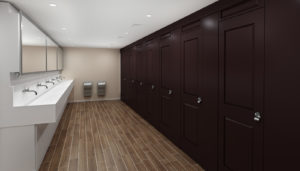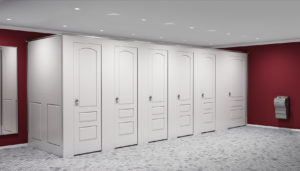When redesigning a commercial bathroom or adding lockers to a locker room or hallway, architects are burdened with a significant amount of detailed planning. Functionality, convenience, and design need to be considered through each step of planning to completion. Because of the numerous working elements that go into building a new bathroom or locker room, it’s easy for architects to overlook some crucial aspects of two of the most important pieces of infrastructure in the entire design: bathroom partitions and lockers.
To work toward a more convenient and more cost-efficient commercial bathroom and locker installation for architects and facility managers, Scranton Products is here to highlight seven crucial mistakes that architects may make when choosing bathroom partitions and locker materials.
Here’s a list of the most common mistakes you’ll want to avoid when picking out your bathroom partitions or locker materials.
Choosing Lockers and Partitions That Lack Durability
Too often, architects forget about the importance of the durability of locker and partition material. It can be easy to think that since these materials aren’t exposed to the natural environment, their durability doesn’t matter. However, many factors can affect the lockers or partitions and even reduce their physical appeal, such as graffiti and scratches. The more durable your lockers and partitions are, the less those factors will contribute to devaluing them. If you take the time to look into high-density polyethylene (HDPE) material, you’ll see how it can improve the durability of your partitions and lockers.
Not Considering Germ Resistance
Bathrooms and locker rooms can be cesspools of germs and bacteria. Thanks to high levels of moisture, it’s easy for bathroom partitions to accumulate mold or mildew. Results from a laboratory test showed that, for a clean and healthy bathroom, opting for HDPE bathroom partitions such as Hiny Hiders Partitions gives you more microbial resistance than phenolic bathroom partitions.
Building Lockers and Partitions That Aren’t Reliable
Reliable and strong materials will help to maintain your lockers and bathroom partitions so they remain appealing and functional over time. Sometimes certain materials don’t serve as reliable bathroom partitions or lockers, which can lead to the following:
- Rust and corrosion
- Dents
- Screw release
You’ll want to choose a strong material, like HDPE, that can withstand these common issues.
Using Non-Sustainable Material
When architects don’t choose sustainable, environmentally friendly materials for bathroom partitions or lockers, they limit the reusability of the materials and aren’t building in the most environmentally friendly way. When building your bathroom partitions, you want to make sure that you use sustainable products, such as the HDPE you’ll find in Hiny Hiders Partitions, for several reasons:
- HDPE Hiny Hiders Partitions are 100% recyclable and are available with up to 100% post-consumer content, unlike phenolic material and SCRC.
- HDPE Hiny Hinders Partitions feature 25% to 100% pre-consumer content, while SCRC has none and phenolic material has a maximum of 22%.
- Unlike phenolic material, HDPE Hiny Hiders Partitions have low-emitting materials and are free of urea-formaldehyde resins.
Not Accounting for Locker Noise Level
The noise made from just one locker being slammed shut can be excruciating. Now multiply that by 10, 15, 20, or more, and you’ll have one booming sound. This is a critical aspect of lockers that architects don’t tend to account for when selecting their locker material. If you’re building lockers in hallways or rooms with shared walls, you want to be sure that you opt for the quietest ones available. Too often architects automatically settle on metal lockers, which create a loud, distracting environment around the locker room. HDPE Lockers are built to be three times quieter than generic metal lockers.
Overlooking Aesthetics
A mistake that architects frequently make is overlooking the aesthetics of different locker materials. While it’s easy to think that all lockers essentially accomplish the same goal and that their looks don’t really matter, there are some significant benefits that go far beyond beautification. For example, traditional metal lockers continually fail to advance their design with their protruding vents and bulky locks.
Duralife HDPE lockers solve both of these issues by breaking away from the confines of generic and bulky locker construction. Duralife lockers have vents cut into the locker surface and have built-in combination locks, resulting in a sleek-looking locker that eliminates the risk of students getting clipped by locker pieces extending past the surface.
Ignoring Future Maintenance Costs
When installing bathroom partitions or lockers, you want the price of building them to be the only cost that you have to worry about. You don’t want to have to throw away money each week for locker or partition maintenance that you weren’t aware would be so recurrent. Unfortunately, this is the result of a mistake that architects frequently make. Think about the common maintenance requirements for SCRC and phenolic bathroom partitions and metal lockers:
- Rust and corrosion
- Dents
- Scratches
- Lack of screw retention
- Mold and mildew buildup
- Germ growth
- Graffiti
Fortunately, HDPE bathroom partitions and lockers are designed to withstand these harmful issues. That means maintenance costs of HDPE material is much lower, so over time, they’re a financially viable solution compared to their competitors.
Making the Right Decisions
Architects and facility managers can make numerous mistakes when selecting materials for new bathroom partitions or lockers, all of which lead to constant inconveniences. When architects make any of the following mistakes:
- Choosing less durable materials
- Not considering germ resistance
- Building with unreliable materials
- Thinking sustainability isn’t a factor
- Not accounting for noise levels
- Overlooking aesthetics
- Ignoring future maintenance costs
The result is usually bathroom partitions and lockers that don’t perform as desired. The truth is that many architects frequently make these mistakes because they don’t know about the benefits of HDPE materials. When you choose HDPE Hiny Hiders bathroom partitions or Duralife lockers, you opt for materials that are more durable, safer, convenient, and more cost-effective, leading to lower maintenance costs and a longer lifespan.
Want to learn more about HDPE products can benefit your facility? Contact us at Scranton Products!


 Aria Partitions™ can add a lot of benefits to your bathroom. These enclosed stalls deliver the latest in extreme privacy because they take away the sightlines that are commonplace with most commercial restrooms and partitions. These partitions go from floor to ceiling, eliminating the chance for your feet to be seen or from you being watched from overhead. The partitions also offer a clasp door, which allows the partitions to be shut completely without any gap between the door and frame that may make you visible or vulnerable. Occupants can freely go to the bathroom without being seen or spotted.
Aria Partitions™ can add a lot of benefits to your bathroom. These enclosed stalls deliver the latest in extreme privacy because they take away the sightlines that are commonplace with most commercial restrooms and partitions. These partitions go from floor to ceiling, eliminating the chance for your feet to be seen or from you being watched from overhead. The partitions also offer a clasp door, which allows the partitions to be shut completely without any gap between the door and frame that may make you visible or vulnerable. Occupants can freely go to the bathroom without being seen or spotted.

